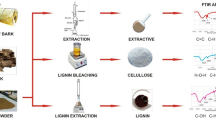Abstract
Lack of data especially pertaining to the chemistry of mangrove wood species makes it difficult to prepare successful plans for their conservation and to use mangroves as a source of wood fiber. In this paper, chemical characterizations of the six main mangrove species of Bangladesh [namely Keora (Sonneratia apetala), Geoa (Excoecaria agallocha), Bine (Avicennia alba), Sundari (Heritiera fomes) Pashur (Xyloccarpous mekongests), and Kakra (Bruguiera gymnorhiza)] were investigated. The chemical results revealed that these species contain high percentages of dichloromethane followed by methanol extractives. Methanol extracts in Pashur, Sundari, and Bine were higher than 10%, which indicates high percentage of tannin material. The total lignin content in these species was higher than 25%, except for Gewa (23.6%) and Pashur (21.3%), which is higher than that of the normal range of hardwood. The pentosan content in these six species was within the range of 19.4–22.8%. The α-cellulose content in Keora and Gewa was acceptable for pulp production, but the others were lower than the normal range of hardwood. Alkaline nitrobenzene oxidation showed that all these species had a very high syringaldehyde to vanillin (2.6–5.0) ratio except Keora (1.6). Surprisingly, rhamnose is the main constituent with xylose of hemicelluloses of these six mangrove species. The ash content in these six mangrove wood species was also higher than that in normal hardwood.
Similar content being viewed by others
References
Anon (2001) The Bangladesh tropical conservation fund: preventing and arresting accelerating species loss in Bangladesh. Chemonics International Inc., Washington, DC
Anon (2003a) Population census 2001. National report (Provisional), Bangladesh Bureau of Statistics, Planning Division, Ministry of Planning, Dhaka, BD
Anon (2003b) State of world forests 2003. http://www.fao.org
Creighton RHJ, Gibbs RB, Hibbert H (1944) Studies on lignin and related compounds LXXV: alkaline nitrobenzene oxidation of plant materials and application to taxonomic classification. J Am Chem Soc 66:32–37
Fengel D, Wegener G (1984) Wood, chemistry, ultrastructure, reactions. W. De Gruyter, New York
Gellerstedt G, Gustafsson K, Lindfors EL (1986) Structural changes in lignin during oxygen bleaching. Nord Pulp Pap Res J 1:14–17
Hoque AKF, Datta DK (2005) The mangroves of Bangladesh. Int J Ecol Environ Sci 31:245–253
Jahan MS, Mun SP (2003) Characterization of Nalita wood (Trema orientalis) as a source of fiber for papermaking (part I): anatomical, morphological and chemical properties. Polpu Chongi Gisul 35(5):72–76
Jahan MS, Mun SP (2004) Effect of tree age on the soda-anthraquinone pulping of Nalita wood (Trema orientalis). J Ind Eng Chem 10(5):766–771
Jahan MS, Mun SP (2005) Effect of tree age on the cellulose structure of Nalita wood (Trema orientalis). Wood Sci Technol 39(5):367–373
Jahan MS, Mun SP (2006) Characteristics of milled wood lignin isolated at different ages of Nalita wood (Trema orientalis). Cellul Chem Technol 40(6):457–467
Jahan MS, Mun SP (2007) Characteristics of dioxane lignins isolated at different ages of Nalita Wood (Trema orientalis). J Wood Chem Technol 27(2):83–98
Jahan MS, Sabina R, Rubaiyat A (2008) Alkaline pulping and bleaching of Acacia auriculiformis grown in Bangladesh. Turk J Agric For 32(4):339–347
Kavanagh KR, Pepper JM (1955) The alkaline nitrobenzene oxidation of aspen wood and lignin model substances. Can J Chem 33:24–30
Mansyur E, Soegiarti Elly Y (1974) Mangroves as raw material for pulp and paper. II. Chemical composition. Berita Selulosa 10(1):37–43
Miles DH, Kokpol U, Chittawongl V, Pyang ST, Tunsuwan K, Chi Nguyen (1997). Mangrove forests—the importance of conservation as a bioresource for ecosystem diversity and utilization as a source of chemical constituents with potential medicinal and agricultural value. Invited lecture presented at the International Conference on Biodiversity and Bioresources: Conservation and Utilization, Phuket, Thailand, 23–27 November 1997
Mun SP, Wi H (1991) Alcohol-bisulphite cooking of Hyun-Aspan wood-characterization of carbohydrates and lignin in the spent liquor. Polpu Chongi Gisul 23(4):25–32
Neto CP, Silvestre AJD, Evtuguin D, Freire CSR, Pinto PCR, Santiago AS, Fardim P, Holmbom B (2004) Bulk and surface composition of ECF bleached hardwood kraft pulps. Nord Pulp Pap Res J 19:513–520
Neto CP, Evtuguin DV, Pinto P, Silvestre A, Freire C (2005) Chemistry of plantation eucalypt: specificities and influence on wood and fibre processing. 13th international symposium on wood, fibre pulping chemistry, Auckland, New Zealand, 2005. Proceedings Book, vol II. pp 431–438
Pietarinen S, Willför S, Holmbom B (2004) Wood resin in Acacia mangium and Acacia crassicarpa wood and knots. Appita J 57:146–150
Pietarinen SP, Willför SM, Sjoholm RE, Holmbom B (2005) Bioactive phenolic substances in important tree species. Part 3. Knots and stemwood of Acacia crassicarpa and Acacia mangium. Holzforschung 59:94–101
Pinto PC, Evtuguin DV, Neto CP (2005) Effect of structural features of wood biopolymers on hardwood pulping and bleaching performance. Ind Eng Chem Res 44:9777–9784
Sarkanen KV, Hergert HL (1971) Classification and distribution. In: Sarkanen KV, Ludwid CH (eds) Lignins: occurrence, formation, structure and reactions. Wiley, New York, p 71
Siddiqi NA (2001) Mangrove forestry in Bangladesh. Institute of Forestry and Environmental Sciences, University of Chittagong, Bangladesh
Singh MM, Chopra R, Karira BG (1981) High yield pulps from mangrove species of Andaman/Nicobar Islands. IPPTA J 18(1):1–4
Sjöstrom E (1993) Wood chemistry. Fundamentals and applications, 2nd edn. Academic Press, San Diego
TAPPI Test Methods (2004) Carbohydrate composition of extractive-free wood and wood pulp by gas-liquid chromatography (T249 cm00). Atlanta, GA
Timell TE (1967) Recent progress in the chemistry of wood hemicelluloses. Wood Sci Technol 1:45–70
Willför S, Sundberg A, Pranovich A, Holmbom B (2005) Polysaccharides in some industrially important hardwood species. Wood Sci Technol 39:601–617
Acknowledgments
The authors wish to thank the Ministry of Science, Information and Communication Technology, Government of Bangladesh, for providing financial support from Special Allocation Project to carry out this research. The authors also wish to thank Thioni Schafer, University of New Brunswick, Canada, for her valuable suggestions, especially in linguistic correction.
Author information
Authors and Affiliations
Corresponding author
Rights and permissions
About this article
Cite this article
Mun, S.P., Jahan, M.S., Al-Maruf, A. et al. Chemical characterization of six mangrove species in Bangladesh. Wood Sci Technol 45, 281–288 (2011). https://doi.org/10.1007/s00226-010-0333-7
Received:
Published:
Issue Date:
DOI: https://doi.org/10.1007/s00226-010-0333-7




